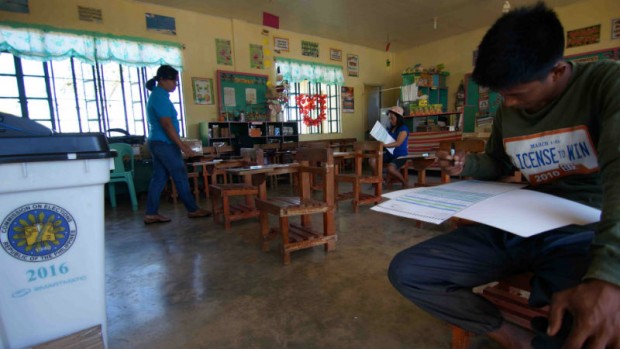
MOCK POLL A young voter from Barangay Linmansangan, a remote village in Alaminos City in Pangasinan province, participates in amock election conducted by the Commission on Elections in 20 selected sites across the country on Saturday. BUDANG NISPEROS / INQUIRER NORTHERN LUZON
PRACTICE makes perfect.
The Commission on Elections (Comelec) is considering conducting another round of mock polls before the May 9 balloting in a bid to improve the voting process and fix the glitches that attended the dry run held over the weekend in selected areas nationwide.
“I believe that the more practice we do, the better. We should also look into the possibility of widening the scope of the exercise so we can fully observe the system end to end,” Comelec Chair Andres Bautista said in an interview over dzBB radio Sunday.
But he noted that each dry run would entail expenses. “So it won’t be that easy,” he said, adding that the Comelec would likely schedule another test run of the transmission system in April.
The Comelec described the mock polls conducted on Saturday as generally a success, with 92 percent of selected clustered precincts in various locations able to quickly transmit results to the National Board of Canvassers stationed at the Comelec’s leased warehouse in Sta. Rosa, Laguna.
Bautista said 37 out of the 40 clustered precincts were able to transmit results within two hours after the voting ended. “That’s a good omen to us,” he said.
Two of the clustered precincts—in Quezon City and in Manila—simulated the actual voting time from 7 a.m. to 5 p.m. so they were not included in the report.
Bautista said the Comelec would also be using SIM cards in the next round of transmission tests in April.
He said that on Election Day, many voting machines would rely on SIM cards in transmitting results from the voting centers. He said telecommunication providers were not ready yet for this.
Bautista also identified other aspects that needed improvement, including the proper shading of the ballot, the correct placement of signatures by the members of the Board of Election Inspectors (BEI), and the right way to feed the ballot into the machines.
He said the poll body observed that the vote counting machines rejected ballots with signatures of the BEI that went beyond the designated box.
Votes were not counted properly with undershaded ballots, he added.
In some of the precincts, voters took more than 10 minutes to cast their ballots—way beyond the estimated ideal time for voting of two to three minutes.
Bautista said the mock polls showed the need to ramp up voters’ education for a more successful and orderly balloting.
“It was a good learning experience. At least we already saw what are the things we still need to fix, like for example, in terms of voter education,” he said. “What we don’t want is for the voting process to be too long as it might result in our voters getting impatient and discouraged to cast their votes.”
Presidential Communications Secretary Herminio Coloma Jr. said over state radio Sunday that the Comelec should address concerns that emerged on Saturday “to ensure the conduct of honest, orderly and credible elections this coming May.”
“The exercise underscored the need to create heightened awareness among voters of what they need to do to be able to perform their civic duty properly,” Coloma said.
“It also showed Comelec the potential glitches that need to be addressed in terms of transmission and other technical problems that could hamper voting and the sending of results,” he added. With a report from Jerry E. Esplanada

